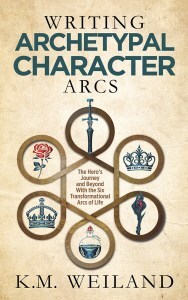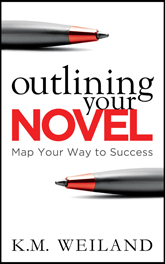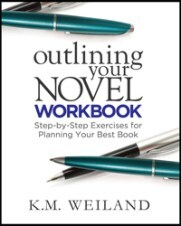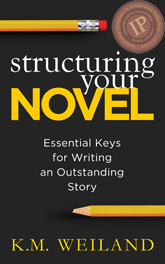Master List of Answers to Most Asked-For Writing Topics on This Site
 You who read this site and participate in the discussions are an endless source of inspiration to me. This is true in many ways, but most literally in that when you ask deeply insightful questions, you often give me great ideas for posts about writing topics!
You who read this site and participate in the discussions are an endless source of inspiration to me. This is true in many ways, but most literally in that when you ask deeply insightful questions, you often give me great ideas for posts about writing topics!
A few months ago, I asked you all to tell me what kind of posts you’d like me to write in the future, and the response was tremendous. Thank you for all the great ideas! I have already posted on some of the topics you suggested and will continue to do so throughout next year.
As I’ve been going through the list of your questions, I’ve been noticing that quite a few are asking for topics I’ve already covered. Because the site is always welcoming new visitors and because, after 15 years and almost 1,600 posts, it is quite comprehensive, I wanted to take this opportunity to respond to some of these queries by creating an easy-to-scan list with links to articles I’ve already published on these writing topics.
>>See this post for more of the site’s resources that you may not know about.
Also, for those who are unaware, the site is very searchable. If you’re looking for a particular topic, just use the search bar. If you’re on a computer, this will show up at the top of the right-hand toolbar (just above my headshot).
If you’re on a mobile device, you’ll need to scroll down, almost all the way to the bottom (again, it will be just above my headshot).
You can also access articles by category (such as Characters, Dialogue, POV, etc.), using the drop-down menu entitled Categories, which you can find toward the bottom of the right-hand column (on a computer) or at the bottom of your screen (on a mobile device).
You can also check out “The Ultimate Glossary of Writing Terms,” an extensive list that includes both definitions and links to relative articles.
Now, without further ado, here are some of your questions and the posts that may help you answer them.
Rewriting to Adjust Word CountAnne: I’d like to learn how to rewrite/edit a large manuscript (115,000 words) into a tight 75,000 words.
5 Ways to Trim Your Book’s Word Count, Pt. 1 of 25 (More) Ways to Trim Your Book’s Word Count, Pt. 2 of 2sanityisuseless: How do you lengthen your novel? (I can’t seem to break even 20K on my novel.)
5 Fun and Easy Ways to Lengthen Word CountHistorical Researchbertram1414: I’d like to learn about historical research, tbh, but I don’t know where to look.
7 Easy Ways to Research a Historical NovelNovel Research: 12 Ways to Ace Your BookHow to Research Your Book Smarter, Instead of Harder5 Tips for Maximizing Your Novel ResearchSelf-Publishing and Self-EditingJason P: I’d love to see updated self-publishing info and more on self-editing.
15 Steps to Self-Publish Your BookThe 6-Part Process to Successfully Self-Publishing Your BookHow I Self-Edit My Novels: 15 Steps From First Draft to PublicationHow to Edit Fiction: Watch Me Correct My Own Story in Real TimeDeath Scenesconfidential writer: One thing that would be really helpful is if you wrote a post about how to write solid death scenes or scenes of a similar dramatic level without them being mellodramatic.
How to Kill a Character—And Avoid Hate MailHow to Write a Gut-Wrenching Tragic Scene—Thanks to One Surprising Detail!Action Scenesconfidential writer: Also, maybe something about how to write good action scenes (like chases, duels, etc).
How (Not) to Write Satisfying Action ScenesThe Key to Writing Good Action Scenes (Hint: It’s Not Just the Action)The Kung Fu Panda Guide to Writing Action ScenesHow to Write Realistic Fight ScenesHow to Keep Your Fight Scenes Interesting5 Keys to Writing Epic Battle ScenesHeroine’s Journey
Coming this winter!
Elisabeth: First off, I love your blog! It has taught me so much about writing. I would love to read about the Hero’s journey, and the variations between male and female journeys.
How to Write Archetypal Character Arcs (full series) (and there’s a book coming out this winter, so COVER REVEAL! :D)Outlining Your NovelJoe Copeland: Right now, my biggest interest is organizing my novel project prior to writing. I have many things I like to refer back to while writing such as character lists, character biographies, major scenes, basic plot, basic backstory, etc. I’m fashioning a list of my favorite things, but I was wondering what things you like to have before starting.

Outlining Your Novel (Amazon affiliate link)
Rick: I would like to know how (i.e. what process and tools you use ) you organize your thoughts/ideas when starting to write a book. Do you start from a big picture overview and then identify the individual scenes, or do you start from the beginning of the story and go forward in time or ? I assume you create an outline, but how do you incorporate character arcs, key plot points, etc. into the outline?
Steve: I would love to hear more about the beginnings of the process. Most specifically going from a very rough idea to a plot line and story structure. Then how you go from a simple plot line to one that has sub plots and interesting twists.

Structuring Your Novel Workbook
Book: Outlining Your Novel Book: Outlining Your Novel Workbook Software: Outlining Your Novel How to Outline Your Novel (full series)The Great Novel-Writing Checklist 6 Tasks You’ll Love Yourself for Checking Off Your NaNo Pre-Writing ListHow I Use Scrivener to Outline My NovelsHow to Use Your Outline When Writing Your First DraftPacingXavier Basora: Pacing. What is it and how you incorpoate it in stories.
Learn How to Pace Your Story (and Mind-Control Your Readers) in Just 8 StepsHere Are 5 Great Ways to Pace Your Story4 Pacing Tricks to Keep Readers’ Attention2 Simple Pacing Techniques That Grab Reader Emotions5 Ways to Use Pacing to Write a Powerful StoryToolsJohne Cook: I’m curious about your tools. There was a time you were using yWriter, what writing tools are you using in 2022?
The Professional Writing Resources I Use for All Parts of the Writing and Publishing Processes (I published this two years ago, but it’s still up to date with my process)Second Act
Structuring Your Novel (Amazon affiliate link)
Milin Joshi: Writing the 2nd act.
Understanding the Adventure World of a Story’s Second ActThe Secrets of Story Structure: The First Half of the Second ActThe Secrets of Story Structure: The Second Half of the Second ActCreating Stunning Character Arcs: The First Half of the Second ActCreating Stunning Character Arcs: The Second Half of the Second ActHow to Write a Flat Character Arc: The Second ActHow to Write a Negative Character Arc: The Second ActHow Story Structure Prevents “Saggy Middle” SyndromeWhat Are Pinch Points? And How Can They Make Your Book Easier to Write?ConflictArdra: Please write about CONFLICT.
There seem to be two types of conflict:
pleasurable to readhostile engagements.For instance nice conflict includes problem solving, convincing someone, battles, mysteries, any occasion that enables the MC to display skill in an interesting way etc
Hostile engagements are unpleasant to read and leave one tired. They’re mostly centered on people being horrible to each other, aggressiveness for its own sake, internal monologue that displays envy and incompetence etc.
Insecure writers (and I realized I do this as well) tend to jump into the hardest situation possible, which is typically about people being unreasonable and aggressive. This makes for very unpleasant reading and stupid characters.
How do I internalize writing nice conflict and keep on track with it?
Conflict in Fiction: What It Really Is and Why It’s Important to PlotStructuring Your Story’s Scenes: Options for Conflict in a SceneCreating Your Character’s Inner Conflict: Want vs. NeedHow to Create Meaningful Obstacles Via ConflictAn Easy Way to Notch Up Your Scene Conflict4 Places to Find Your Best Story ConflictLearn to Write Deep and Rich Story ConflictThe Pixar Way to Think About Story ConflictThe Four Different Types of Conflict in DialogueMost Common Writing Mistakes: One-Dimensional ConflictTheme
Writing Your Story’s Theme (Amazon affiliate link)
Amy: Can you write about how best to shape or mine ideas or theme into compelling stories
Book: Writing Your Story’s Theme Deepening Your Story’s Theme With the Thematic SquareWhat Is the Relationship Between Plot and Theme?4 Ways to Choose a Better Theme for Your BookHow to Write Unique ThemesRevisionGalynn D Zitnik: I am in the middle of revising my novel and it is so easy to get lost and confused. Do you have an efficient system for revising?
6 Tips for How to Organize Your Novel’s EditsYour NaNo Novel Is a Hot Mess! How to Edit Your Book5 Steps to a Thorough Book EditWriting Funny CharactersShelley Lea Frost: Hi Katie, thanks so much for all your wonderful advice. Your insight and the effort you put into helping others are much appreciated. Do you have any words of wisdom about writing witty characters? I love people with a sense of humour but struggle to make the jokes and repartee sound different. I only have a single small sad supply of wit and it won’t stretch enough to create characters with different voices. All my funny sounds the same. Should I continue to stalk my friends? They’re starting to look cross when I stick my phone in their faces every time someone laughs. Please give me some options. For the sake of my social life and my potential writing career.
How to Write Funny6 (More) Ways to Improve Your Book by Writing HumorHow to Write Funny DialogueThe Hilarious 2-Step Plan for Writing Humor in Fiction4 Ways to Write Meaningful ComedyDaydreamingPeter Samet: I’ve realized that I don’t daydream nearly as much as I used to. I partially blame my smartphone, which prevents me from ever getting bored, but also discourages one-on-one time with my brain. How important is daydreaming for writing, and how does one make time for it when one barely has time to write either?
What Is Dreamzoning? (7 Steps to Finding New Story Ideas)3 Ways to Learn How to Daydream BetterHow to Cultivate DaydreamsNovel DoubtsRiley G.: What do you do with a scene in a novel that you liked when you first wrote it, but don’t like so much when you reread it? And how do you know what to replace the scene with, or how do you know that a new idea to replace said scene is the right thing to replace it with? How do you deal with second thoughts when working on a manuscript?
Writing as the Art of Thinking Clearly: 6 Steps10 Steps for Working Past the “This Stinks” BluesWhy Every Story You Write Is a Guaranteed FailureDeciding Which Idea to WriteMiriam Harmon: Though, I used to have shiny object syndrome, now that I’ve gotten over it, I have more stories than I know how to write. Now I’m stuck wondering which of these stories I should focus on. Should I start with something easier or go for my best book idea, and which is my best book idea? Every time I try to narrow them down, I end up with ten or more stories that really deserve to be written, and I’m not sure how to choose which one to do right now. Any advice?
nick: I have so many ideas, how do I choose which idea to work on next? I’m just finishing up my first book, and it felt so pressing and all consuming for years, now I’m afraid I won’t feel that pressing importance again.
Betsy W.: Thank you for all that you create! How do you know when an idea is worth turning into a novel? Do you have a feeling about the general idea that tells you it’s enough for a novel? Or is there a list of questions you ask yourself about the idea to test it out? Thank you for the stories you tell and for all the ways you help writers.
7 Ways to Decide Which Story Idea You Should Write Next6 Ways to Find Your Best Ideas Before You Start Writing7 Ways to Decide Which Story Idea You Should Write NextNew Story Ideas Distracting You From Your Book? Find Out What You Should DoThe 6 Challenges of Writing a Second NovelSubplotsLorraine: How do you go about layering subplots into the main story? Do you write the main story first and then add in the subplots while you edit or do you include it in the story plan? I’m currently adding in a romantic subplot into my urban fantasy book. While there were elements during the editing process, it wasn’t until I was almost at the polishing stage I realized the romantic subplot didn’t have enough meat. Hence the question.
5 Tips for Organizing SubplotsCan a Character’s Arc Be a Subplot?How to Keep the Wrong Subplots From Sinking Your StoryTitlesAndrew Williams: I struggle enormously with decent titles. I can spend a year writing and editing something under a working title and still have no idea what to call it at the end. Do you have any advice on coming up with memorable, searchable titles for our writing projects?
17 Steps to a Reader-Grabbing TitleGet Your Novel Noticed with a Power-Packed TitleHow to Choose a Book Title That’s Perfect for Your Story AND Good Marketing!SubtextMurli: How to make subtext impactful?
The Only 5 Ingredients You Need for Story Subtext4 Ways to Amplify Your Characters’ SubtextHow to Write Subtext in DialogueFind Out if Your Prologue Is Destroying Your Story’s SubtextHow to Create Subtext by Letting Your Readers Fill in the BlanksSubtext in Dialogue: 5 Places Where Your Characters Should Stop TalkingSubtext: The Art of Iceberging***
Many of the posts listed here are comprehensive. A few are not, and I may return to these topics in more depth in the future. For now, thanks for the inspiration, and I hope you find some of the answers you were hoping for. If not, stay tuned!
Wordplayers, tell me your opinions! Are there any more writing topics that you’d like me to cover in the future? Tell me in the comments!The post Master List of Answers to Most Asked-For Writing Topics on This Site appeared first on Helping Writers Become Authors.





